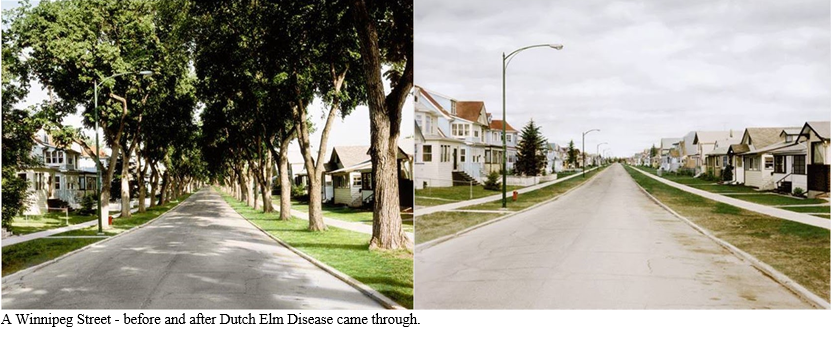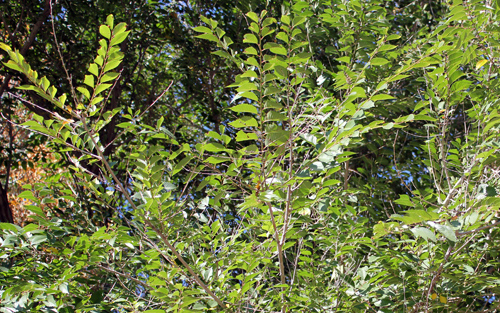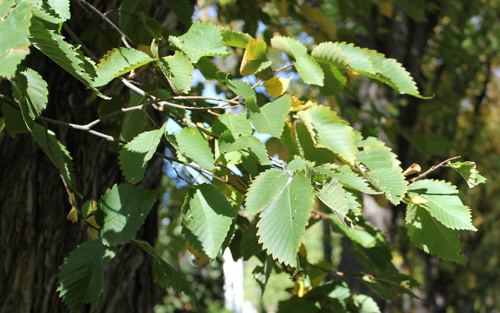
Identifying Your Elm
Dutch Elm Disease can infect all types of elms in Saskatchewan. American, Siberian & Manchurian elms are all susceptible and must be treated equally. American elms are the most common shade tree found in the older neighbourhoods of Saskatoon. In fact, there are as many as 100,000 in the city. American elms are native to Saskatchewan and therefore ideally suited to our cold, harsh climate. They can live for 250 years or more in our urban setting, providing beauty and shade for generations to come.
American elms have a characteristic "umbrella" shape when seen in profile, growing to 23 metres (75 feet) in urban conditions. The canopy of mature trees will often meet across a street creating an attractive "tunnel" of branches and leaves. Its dark green leaves are oval in shape and asymmetrical (having halves that are not even in size and shape) at the base. The leaf edges are double-toothed.
Siberian elms (often called Manchurian elms) are less graceful and majestic than the American elm. A hardy, weedy, and relatively short lived species, the Siberian elm can have a variety of forms depending on location and pruning – from a shrubby hedge to a single tree. Their leaves are similar to, but smaller than, those of the American elm. Siberian elms are fast growing, typically reaching heights of 12 m (40 ft). They are unpopular with gardeners as they produce an abundance of seed and their branches break easily. They are less likely to die from DED, but can be a source of infection.
The following drawings illustrate the leaves of each tree; American elm leaves are typically larger than Siberian elm leaves.

Dutch Elm disease
Tree populations in Saskatchewan are subject to numerous stresses. Currently the most serious threat comes from Dutch Elm Disease (DED), a deadly disease of American elm trees.
- Cause: a fungus under the bark of infected elms
- Carrier: elm bark beetles that feed on, and breed in elm bark.
- Victim: American elms, our most magnificent shade tree.
- Symptoms: Leaves that wilt, curl up and turn brown in summer.
- Control: Frequent pruning to remove dead wood, immediate removal of dead elms and careful disposal of prunings and firewood.
How Does Dutch Elm Disease Spread?
Elm bark beetles spread the disease along natural corridors of American elms, such as the Saskatchewan, Qu'Appelle, Souris and Frenchman river valleys. Eventually they reach a community like Prince Albert or Saskatoon. Carrying the fungus on their bodies, the beetles infect elms as they feed. DED kills the tree and the beetles are forced to find other elms. These new elms will in turn die and the cycle continues.
People spread DED by transporting infected wood. By this means DED can strike your community overnight. For this reason it is illegal to transport or store elm firewood in Saskatchewan.
How can we protect Saskatoon from Dutch Elm Disease?
Saskatoon is almost the last major city in North America that has a significant population of American Elms and no DED (until July 2015). American elms have no resistance to DED, so early detection is essential to prevent an outbreak. We are surrounded by sites that have active disease. DED has now been discovered in various neighbourhoods throughout the city. It is crucial for us to save the 100,000 elms that provide charm and cool summery elegance to our streets.
Be aware if one of your elm trees suddenly has wilting leaves on one of its branches.
- Flagging is a common early sign of Dutch elm disease noticeable when the weather is hot and dry.
- Other diseases also cause wilting, reducing the overall health of the tree.
- For images of diseased elms, go to this page from the City of Saskatoon.
Actions that people can take to help prevent the spread of DED into their communities include:
- Do not transport, sell, store or use elm firewood; it's against the law and one of the main ways that DED can spread.
- Dispose of elm wood properly at the site designated by your municipal authority. In Saskatoon it is at the City Landfill.
- Prune elm trees to keep them healthy, outside the annual ban period (April 1 to August 31). Do not prune elms during the ban period.
- Make sure the tree care professional you hire has the required training. They need to be ISA certified.
- Learn the signs and symptoms of DED and report anything that looks suspicious to local authorities. In Saskatoon call Urban Biological Services at 306 975-2890 or fill out their online form here: On Line Form They will come out to check your tree of concern or identify elm wood if you aren't sure.
You can also contact the Saskatchewan Government at the Inquiry Centre at 1-800-567-4224 or Email. For more information on Dutch Elm Disease, visit the Saskatchewan Government website.



